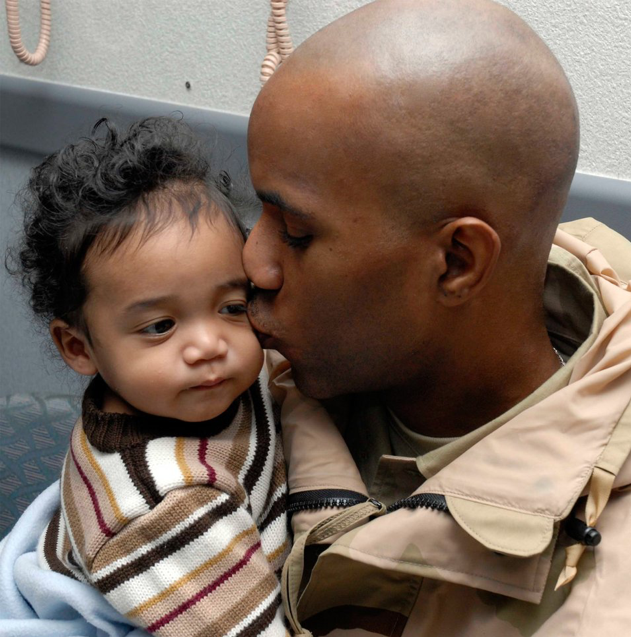In this section, we will discuss the evolutionary function of emotions and how they are affected by social and cultural norms.
9.2.1: Perspectives on Emotions

Attachment theory posits that our relationship and interactions with our primary caregiver(s) will influence emotions and future interpersonal relationships.
How did you learn to express your emotions? Like many aspects of communication and interaction, you likely never received any formal instruction on expressing emotions. Instead, we learn through observation, trial and error, and through occasional explicit guidance (e.g., “boys don’t cry” or “smile when you meet someone”). To better understand how and why we express our emotions, we’ll discuss the evolutionary function of emotions and how they are affected by social and cultural norms.
The fact that human beings were able to group together and create interpersonal bonds was a key element in the continuation and success of our species, and the ability to express emotions played a role in this success (Planlap, Fitness, & Fehr, 2006). For example, unlike other species, most of us are able to control our anger, and have the capacity for empathy. Emotional regulation can help manage conflict, and empathy allows us to share the emotional state of someone else, which increases an interpersonal bond. These capacities were important as early human society grew increasingly complex and people needed to cope as they lived with more and more people.
A dependable and nurturing caregiver helps establish a secure attachment style that will influence emotions and views of relationships in later life. Attachment theory ties into the evolutionary perspective because researchers claim that it is in our nature, as newborns, to create social bonds with our primary caretaker (Planlap, Fitness, & Fehr, 2006). This drive for attachment became innate through the process of evolution because early humans who were more successful at attachment were more likely to survive and reproduce—repeating the cycle. Attachment theory proposes that people develop one of the following three attachment styles as a result of interactions with early caretakers: secure, avoidant, or anxious attachment (Feeney, Noller, & Roverts, 2000). It is worth noting that much of the research on attachment theory has been based on some societal norms that are shifting. For example, although women for much of human history have played the primary caregiver role, men are increasingly taking on more caregiver responsibilities. Additionally, although the following examples presume that a newborn’s primary caregivers are his or her parents, it is also possible that extended family, foster parents, or others may play that role.
Individuals with a secure attachment style report that their relationship with their parents is warm, and that their parents also have a positive and caring relationship with each other. People with this attachment style are generally comfortable with intimacy, feel like they can depend on others when needed, and have few self-doubts. As a result, they are generally more effective at managing their emotions, and they are less likely to experience intense negative emotions in response to a negative stimulus like breaking up with a romantic partner.
People with the avoidant attachment style report discomfort with closeness and a reluctance to depend on others. They quickly develop feelings of love for others, but those feelings lose intensity just as fast. As a result, people with this attachment style do not view love as long lasting or enduring and have a general fear of intimacy because of this. This attachment style might develop due to a lack of bonding with a primary caregiver.
People with the anxious attachment style report a desire for closeness but anxieties about being abandoned. They regularly experience self-doubts and may blame their lack of love on others’ unwillingness to commit rather than their own anxiety about being left. They are emotionally volatile and more likely to experience intense negative emotions such as anxiety and anger. This attachment style might develop because primary caregivers were not dependable or were inconsistent—alternating between caring or nurturing and neglecting or harming.
This process of attachment leads us to experience some of our first intense emotions, such as love, trust, joy, anxiety, or anger, and we learn to associate those emotions with closely bonded relationships (Planlap, Fitness, & Fehr, 2006). For example, the child who develops a secure attachment style and associates feelings of love and trust with forming interpersonal bonds will likely experience similar emotions as an adult entering into a romantic partnership. Conversely, a child who develops an anxious attachment style and associates feelings of anxiety and mistrust with forming interpersonal bonds will likely experience similar emotions in romantic relationships later in life. In short, our lifelong emotional tendencies are influenced by whether we form loving and secure bonds or unpredictable and insecure ones, which inevitably affects our relationships. Of course, later in life, we have more control over and conscious thoughts about this process. Although it seems obvious that developing a secure attachment style is the ideal scenario, it is also inevitable that not every child will have the same opportunity to do so. But while we do not have control over the style we develop as babies, we can exercise more control over our emotions and relationships as adults if we take the time to develop self-awareness and communication competence.